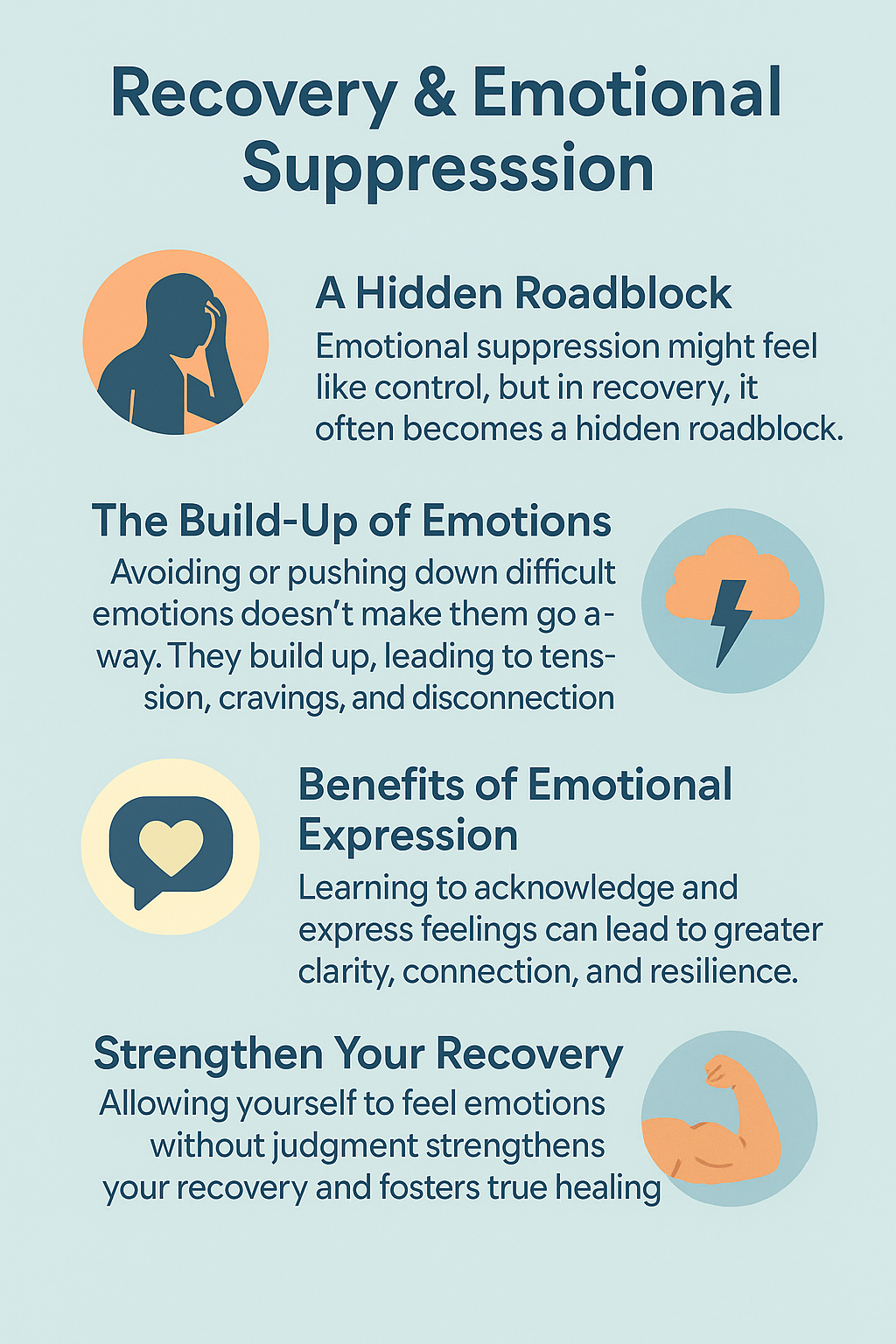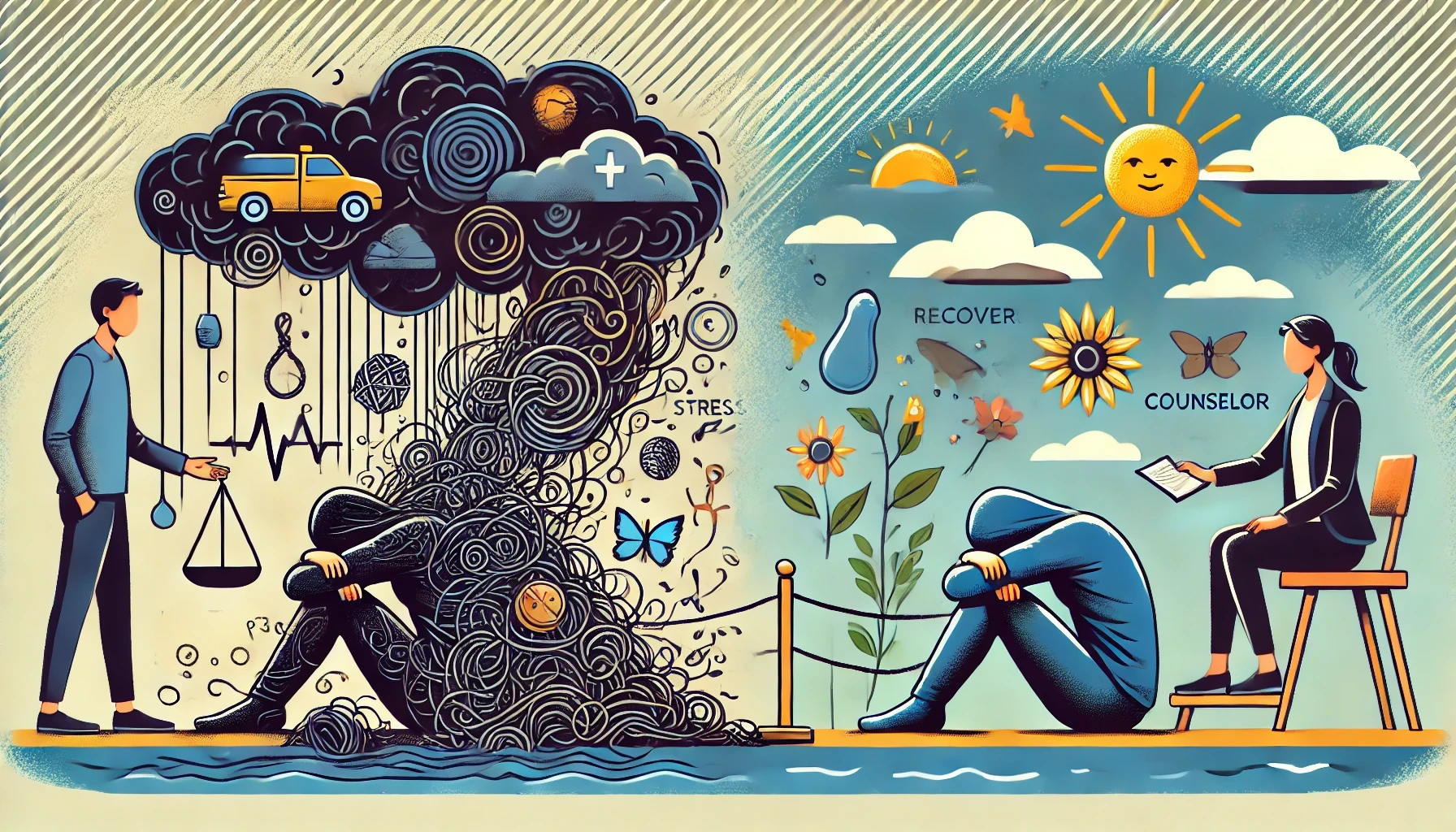Emotional suppression can quietly stall your progress, especially if you’re working through recovery—whether from grief, addiction, or a major life change. Pushing down uncomfortable feelings might seem harmless at first, even helpful, like a way to stay in control. But over time, it becomes a barrier to real healing. You can only hold so much inside before it affects your mood, your decisions, and your ability to cope. From my own experience, I’ve learned how important it is to face what you’re truly feeling instead of bottling it up. When you keep everything inside, the pressure builds and eventually shows up in your relationships, your mental health, and your recovery journey. Acknowledging your emotions isn’t weakness—it’s a powerful step toward lasting healing.
Understanding Emotional Suppression and Its Role in Recovery
Emotional suppression means pushing down or ignoring emotions that feel uncomfortable, messy, or hard to handle. This could be sadness, anger, fear, or even joy. Sometimes, the message to stay “strong” or “positive” is everywhere, making it seem like there’s no place for tough feelings. For people on a recovery adventure, this habit grows stronger because confronting emotions can make things feel more chaotic at first.
It’s pretty standard to see emotional suppression used as a defense against pain. Maybe opening up was met with criticism in the past, or there’s fear that strong feelings will drown out progress. Yet, even when these reasons feel valid, suppressed emotions don’t go away. Instead, they often show up unexpectedly, such as mood swings, anxiety, physical pain, or a general sense of being “stuck.”
Studies back up what I’ve seen in real life, showing that consistently pushing aside emotions can actually slow down or even block recovery. According to the American Psychological Association, suppressing emotions can increase stress responses and lead to health problems over time (source).
Why Suppressing Emotions Can Backfire
Our emotions pop up for a reason; they’re signals that something needs attention. When you push them down, a few things start to happen, and none of them really help you move forward in your recovery adventure.
- Increased Emotional Pressure: Suppressed emotions pile up. Think of it like packing things into a tiny closet. Eventually, the door won’t close, and everything spills out. People often find themselves overwhelmed by small triggers because there’s so much packed away inside.
- Physical Symptoms: Unprocessed emotions can turn into headaches, fatigue, jaw pain, or stomach issues. Emotional stress can quietly wreak havoc on your body, even if you don’t connect the dots at first.
- Relationship Struggles: When emotions are hidden, honest communication becomes tough. Others might sense you’re holding back, making misunderstandings or distance more likely.
- Relapse or Setbacks: In recovery, ignoring emotions means core issues never get resolved. This makes falling back into old habits, like substance use or unhealthy coping, more likely when stress gets high.
Spotting Emotional Suppression in Your Own Life
Catching yourself in the act of emotional suppression is an essential first step. Some markers I noticed in myself and others include:
- Frequently saying “I’m fine” or “It doesn’t matter” when it clearly does
- Trouble naming or describing your feelings beyond “good” or “bad”
- Numbing out with food, social media, work, or other distractions
- Feeling exhausted or unmotivated for no apparent reason
Counselors and therapists often use simple tools to help spot when someone’s suppressing emotions, like mood journals or checklists. Even tracking changes in your sleep, appetite, or energy levels can give clues. If you start to notice physical symptoms, changes in your daily mood, or frequent crying spells you can’t easily explain, these could all be signals to look for ways to give your emotions more space.
Practical Ways to Break Out of Emotional Suppression
Working through emotional suppression doesn’t always mean pouring your heart out at all times. Building a better relationship with your emotions is more about allowing them space and respecting their purpose. Here are some things that worked for me and have helped others along the way:
- Start with Self-Awareness: Take stock of what feelings come up and when you tend to want to stuff them down. Journaling or voice notes can help make sense of patterns. Sometimes, just spending five quiet minutes a day checking in with your body and mood can help make emotional patterns more obvious.
- Practice Naming Your Emotions: Increasing your emotional vocabulary makes a difference. Instead of “bad,” try to identify more specific words like “anxious,” “disappointed,” or “frustrated.” There are apps and emotion wheels that are pretty handy for this, and even sticky notes on a mirror can help in a pinch.
- Find Healthy Outlets: Physical activity, art, or music can help release emotions without overwhelming you. Sometimes just moving your body through yoga or going for a walk lets things out in a safe way. Creative hobbies or crafts can be helpful outlets, too. Try scribbling, humming, or moving to a favorite song when you need a quick release.
- Reach Out for Support: Talking with someone trustworthy can help break the habit of holding everything in. This could be a close friend, a peer support group, or a mental health professional. Online recovery forums, especially if you feel alone in your experience, are helpful for many people.
- Allow Yourself Time: Letting emotions come up is uncomfortable at first. Permitting yourself to sit with feelings—even for just a few minutes a day—can help them feel less scary over time. Remind yourself that emotions, even intense ones, will pass. Practice patience, and don’t judge yourself for how long it takes.
Things to Remember About Working With Emotions
Letting go of emotional suppression takes time and patience. A few things I try to keep in mind that can make the process smoother:
- Your emotions are valid, even if they feel inconvenient or messy.
- There’s no need to “fix” feelings right away. Sometimes the best thing is to notice and accept them.
- Triggers are opportunities; they show where healing can happen if you approach them gently.
- Small progress counts. If you notice yourself pausing for a breath before reacting or identifying an emotion you didn’t spot before, that’s growth.
Also, remember not to compare your experience with others. Everyone processes emotions differently and at their own pace. Allow space for your feelings to shift and change, and be kind to yourself when setbacks happen.
Emotional Suppression in Different Recovery Adventures
Every recovery adventure is different, but emotional suppression tends to show up in similar ways. Here’s how it might play out:
- Addiction Recovery: Past traumas and challenging emotions often get covered up with substances. Working through feelings in therapy without judgment opens the way to real change. Feeling your emotions can help reduce the urge to return to old behaviors.
- Grief and Loss: Pushing away sadness or anger can delay healing. Allowing yourself to mourn can eventually bring relief and a new perspective. Sometimes, talking about your loss openly or creating rituals in memory of what you lost can help bring these emotions forward in a gentle way.
- Mental Health Recovery: Anxiety and depression sometimes get worse with suppression. Learning new coping skills through programs like DBT or CBT helps bring emotions out into the open, making them feel more manageable. Many people find relief when they accept their feelings rather than fight them.
Common Challenges and How to Deal with Them
Tackling emotional suppression isn’t usually a one-and-done task. Some common hurdles can pop up along the way:
- The urge to control or “fix” every feeling as soon as it appears.
- Pressure from family, work, or society to “move on” from difficult emotions.
- Fear that allowing emotions to surface will slow your recovery.
- Confusing emotional numbness with true peace or resilience.
Dealing with these challenges is a process. Therapy, mindfulness, and connecting with supportive communities are all super helpful. Guided meditations or breathwork can also help when strong emotions come up and feel overwhelming. Reading stories of others’ recovery adventures and their honest feelings can provide hope and validation, reminding you that you’re not alone in this.
Valuable Tips for Releasing Suppressed Emotions
Some practical ways to ease emotions out of hiding include:
- Writing letters you never send to get thoughts out.
- Using grounding techniques, like naming five things you can see, feel, or hear, to manage intense feelings.
- Setting aside “worry time” each day for concerns, so they don’t take over everything else.
- Moving through emotions with slow stretching or walks outdoors. Let nature’s calm work in your favor; pay attention to your surroundings and your breath.
- Try creative projects like doodling, knitting, or woodworking. Distracting your hands can allow emotions to slip out more easily than if you force them.
There’s no right or wrong way to process emotions, as long as you’re honest with yourself and not causing harm. What matters is making space for those feelings—even the uncomfortable ones—to have their say. Over time, you’ll notice that emotions come and go, and they don’t have to control your behavior if you remain open and curious about them.
Frequently Asked Questions
Here are some common questions people have about dealing with emotional suppression in recovery:
What are the risks of ignoring or hiding my emotions?
Regularly suppressing emotions can lead to more stress, strained relationships, lower motivation, and even physical health problems like headaches or trouble sleeping. It also makes recovery from difficult experiences slower and more complicated.
Is it possible to learn to express complex emotions even if I have never done so before?
Absolutely. It’s not always easy at first, but small steps like keeping a journal, practicing with trusted friends, or joining support groups make a difference over time. You can even work with a therapist to practice emotional expression in a safe environment.
Should I always share my emotions with others?
No. Sometimes it’s enough to acknowledge them quietly to yourself. Sharing can help, especially with a professional or a close friend, but the main goal is to make sure you’re not avoiding or numbing them out. Find a balance that feels safe and genuine for you.
Can emotional suppression ever be healthy or helpful?
There are moments when holding back emotions for a short time is okay, like getting through a tough work presentation or helping someone in a crisis. Long-term suppression, though, usually leads to bigger problems, so it’s important to find safe spaces to process feelings afterward.
Making Room for Emotions in Recovery
Learning to stop the habit of emotional suppression is really important for anyone hoping to move forward on a recovery path. Opening up to emotions makes them easier to handle, helps you connect honestly with others, and lets the recovery adventure feel more authentic and lasting. Over time, practicing emotional awareness brings more peace, confidence, and real progress than bottling things up ever could. If you’re struggling, reach out to others, read about emotional health, and remember: This is a skill you can grow with patience. The key is not to move faster, but to keep going, even in small ways.
Video: How Emotional Suppression Blocks Healing

